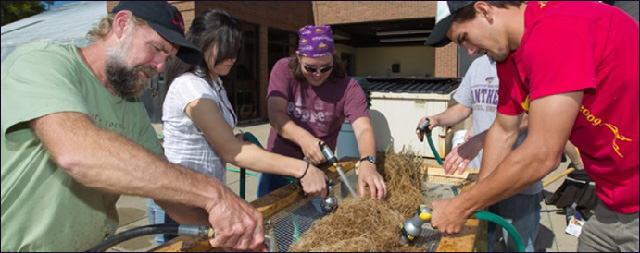
Undergraduate Student Work
Work/Availability
Open Access Undergraduate Student Work
Type of Work
Poster Presentation
Keywords
Prairie reconstruction; Energy crops;
Abstract
Two of the more pressing, yet opposing, ecological challenges that we face at the global-scale are the loss of biodiversity and rising demand for energy. Many ecological experiments have shown the importance of biodiversity for ecosystem services and functions, but the simultaneous demand for energy has led to greater conversion of natural landscapes to low-diversity energy production crops (e.g., corn for ethanol). One potential solution to these seemingly opposing issues would be to grow diverse native vegetation for bioenergy. Native tallgrass prairie produces large amounts of aboveground biomass but also provides great habitat for wildlife and other ecosystem services. In this study, we compared the productivity, yearly biomass variability, and invasion resistance of four potential bioenergy feedstocks with contrasting diversity: 1 species - a switchgrass monoculture; 5 species - a mix of C4 grasses; 16 species - a mix of grasses, forbs and legumes; and 32 species - a mix of grasses, forbs, and legumes. Each diversity treatment was replicated four times on three different soil types (clay, loam, and sand soil) for a total of 48 plots (0.33-0.56ha each). We compared productivity by harvesting all plant material to ground level in 10 randomly placed 0.3m2 quadrats per plot. Weed biomass was compared using basal area sampling of 10 randomly placed 0.1m2 quadrats per plot. Across soil types, the 1, 16 and 32 treatments produced the same amount of aboveground biomass over the 5-yr study, with the 1 treatment producing significantly more biomass than the 5 treatment. Despite the overall similarity between the 1, 16, and 32 treatments, the relative ranking of the four diversity treatments varied depending on soil type. Weed biomass was higher in low-diversity treatments than high-diversity treatments. Year-to-year variation in productivity did not differ between treatments. As we attempt to meet the bioenergy goals mandated by the Energy Policy Act (2005) and Energy Independence and Security Act (2007), our results indicate that diverse mixtures of native tallgrass prairie plants are a reliable source of bioenergy and also provide the ecosystem benefits associated with increased diversity. However, variation in the relative productivity of the four diversity mixtures on different soil types suggests that seed mixes of bioenergy crops must be tailored to their specific site for maximum productivity and stand success.
Date of Work
2016
Department
Department of Biology
Department
Tallgrass Prairie Center
First Advisor
Mark Sherrard
Repository
UNI ScholarWorks, Rod Library, University of Northern Iowa
Copyright
©2016 Jessica Abernathy, Mark Sherrard
Language
en
File Format
application/pdf
Recommended Citation
Abernathy, Jessica and Sherrard, Mark, "The Utility of tallgrass prairie reconstructions as bioenergy feedstocks" (2016). Undergraduate Student Work. 25.
https://scholarworks.uni.edu/ugswork/25


